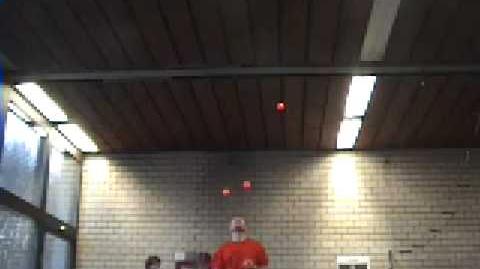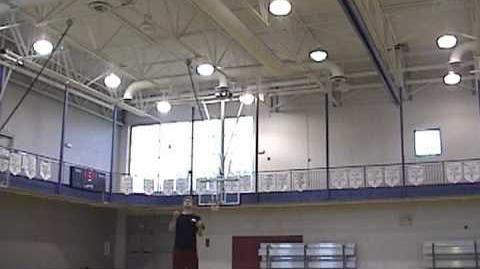
5 Ball shower multiplex transition

37 transitions into mm
Transitions to 5 ball Mills mess by Thomas Dietz

72 (6x,4)* transitions response to ctjuggles-0
Transitions to (6x,4)* by Daniel Eaker

Ways to get into overheads 1
4 club overhead transitions and variations by Julius Preu
A transition is any way of changing from one pattern or trick to another.
- Video: Eden Zak transitioning between bounce juggling and toss juggling with 7 balls
Connections

5 Ball Connection Competition Entry
5 ball connection sequence by Jonah Botvinick-Greenhouse

Hard Ass Catch Connections
5 ball blind catch connections by Jason Garfield

30 Five club 744 combo's-0
5 club 744 connections by Lauri Koskinen

5 club 360s World Record yet again-0
5 club 1 minute 360s world record by Vova Galchenko, with the first nine 5 up 360s connected
A connection is a transition from one trick directly to another with no basic throws in between the two tricks, or any other throws in between that aren't part of either trick.
- Animation: 3 up 360s with set-up throws (not connected)
- Animation: A 7792244 360 connected to a 5 up 360 - there are two throws after the first 360 that aren't part of the second trick, but it's still a connection because those throws are part of the first trick, which is a combination of a 360 and a siteswap.
- Animation: Transition from 645 to 744, ending the 645 pattern with a 5 - not a connection, because it's the same as ending the 645 pattern with a 4 and changing to 744, but with one throw of the basic pattern in between.
Siteswap transitions

23 Ways to Into 4 Ball Shower From Fountain
Transitions to a 4 ball shower by Phil Thompson

5 siteswap enter, exit and reverse 5-ball shower
5 ball shower transitions by Bruce Tiemann: 678 to enter the shower, 817161 to exit the shower, and 8181818 to reverse the direction of the shower.
If two siteswaps both have the same state at some point during the patterns, you can transition from one siteswap to the other any time you get to that state. For example, 663 and 834 both visit the state 111101 (between the 6s in 663 and before the 8 in 834), so those two patterns can be connected:
If two siteswaps never visit the same state, it's impossible to connect them directly. For example, the basic pattern is always in the ground state, but 771 is never in the ground state, so you can't go straight from the basic pattern to 771 - you have to do transition throws in between, to change the state from 11111 to 111011. The simplest way to transition from the cascade to 771 is to throw two 6s. You can transition back to the cascade by finishing any ground state 5 ball siteswap that starts with 66.
Finding transitions

Best Way "Throw Sequence" Brute Force Siteswap Transition Generator 1 Boppo's Whiteboard
Bruce Tiemann shows how to find transitions between siteswaps (part 1, part 2)
Here's an example of a way to find transitions between siteswaps: Say you want to find a 1-throw transition from a 3 ball cascade to a 3 ball shower. Write down the notation for those patterns, with one blank spot in between:
...333333_515151...
For each number in this sequence, go that number of beats to the right of the number and mark the spot below the number you get to.
...333333_51515151... ...3333333331_1515...
This leaves one blank spot in the lower sequence. The lower blank spot is 4 beats to the right of the upper blank spot, so replace the blank spot in the upper sequence with a 4.
...333333451515151... ...333333333141515...
That's the only 1-beat transition from 3 to 51 - a 4. If you wanted a 2-beat transition, there would be two possibilities. Write the notation for the two patterns, with two blank spots in between, and mark the destination of each number:
...333333__51515151... ...333333333_1_1515...
This leaves two blank spots in the lower sequence. If you send the first blank spot above to the first blank spot below, and the second blank spot above to the second blank spot below, you get the transition 34, which is the same as doing the cascade for one more throw and then using the 1-beat transition that we already found.
...3333333451515151... ...3333333333141515...
The other way to connect the blank spots is to send the first blank above to the second blank below, and the second blank above to the first blank below, giving the transition 52. This is a more commonly used transition - doing one high throw and pausing for one beat before going into the shower.
...3333335251515151... ...3333333332151515...
(The lower sequences here are not valid siteswap sequences, they just show the destination of each throw in the upper sequences. But if you read one of the lower sequences backwards, you will always get a valid transition from the second pattern back to the first pattern - a time-reversed version of the transition in the upper sequence.)
There are 6 (3 factorial) possible ways to do a 3-beat transition between two given patterns. Write the patterns with three blank spots in between them, and the destinations of the numbers.
...333333___51515151... ...333333333__1_1515...
The three blank spots in the upper sequence can be connected to the three blank spots in the lower sequence six different ways.
...333333 334 51515151... ...333333 333 33141515...
...333333 352 51515151... ...333333 333 32151515...
...333333 424 51515151... ...333333 333 24141515...
...333333 451 51515151... ...333333 333 14151515...
...333333 622 51515151... ...333333 333 22161515...
...333333 631 51515151... ...333333 333 13161515...
The first, second, and fourth of these 3-beat transitions are the same as the 1-beat and 2-beat transitions. The third transition is like the 1-beat transition 4, but doing two throws of two in one hand instead of just one throw. The fifth transition is like the 1-beat transition, but higher, with a 2-beat pause (which could be used to do a 1 up 360). The last transition is the same as the fifth, but with a 2 ball shower during the pause.
Synch/asynch transitions
The easiest way to find transitions between synch and asynch patterns is to use a ladder diagram. The siteswap notation for synch/asynch transitions involves unusual things like odd numbers in synch pairs and non-crossing odd number throws. An x after an even number turns it into a crossing throw, and an x after an odd number (only used in synch/asynch transitions) turns it into a non-crossing throw. A 1x is a hold, like a 2, but shorter. Normally after each beat in a synch pattern (where two throws are made on the same beat), the next beat is empty (no throws on that beat). Sometimes in a transition from a synch pattern to an asynch pattern, there is no empty beat after the last synch pair. This is indicated by an exclamation mark. In Juggling Lab, the first asynch throw after transitioning from a synch pattern is normally made by the hand opposite the one that made the last asynch throw before the synch section. (The opposite seems to be true in patterns that have either an even number of asynch throws and an asterisk, or an odd number of asynch throws and no asterisk.) You can also put a capital L or R before an asynch section to make it start with a certain hand.
Another way to find a transition between synch and asynch is to use a common notation for states, such as Beatmap-like states where synch and asynch would use the same notation, and then find a path in the state diagram from the cycle that represents the starting pattern to the cycle that represents the ending pattern.
